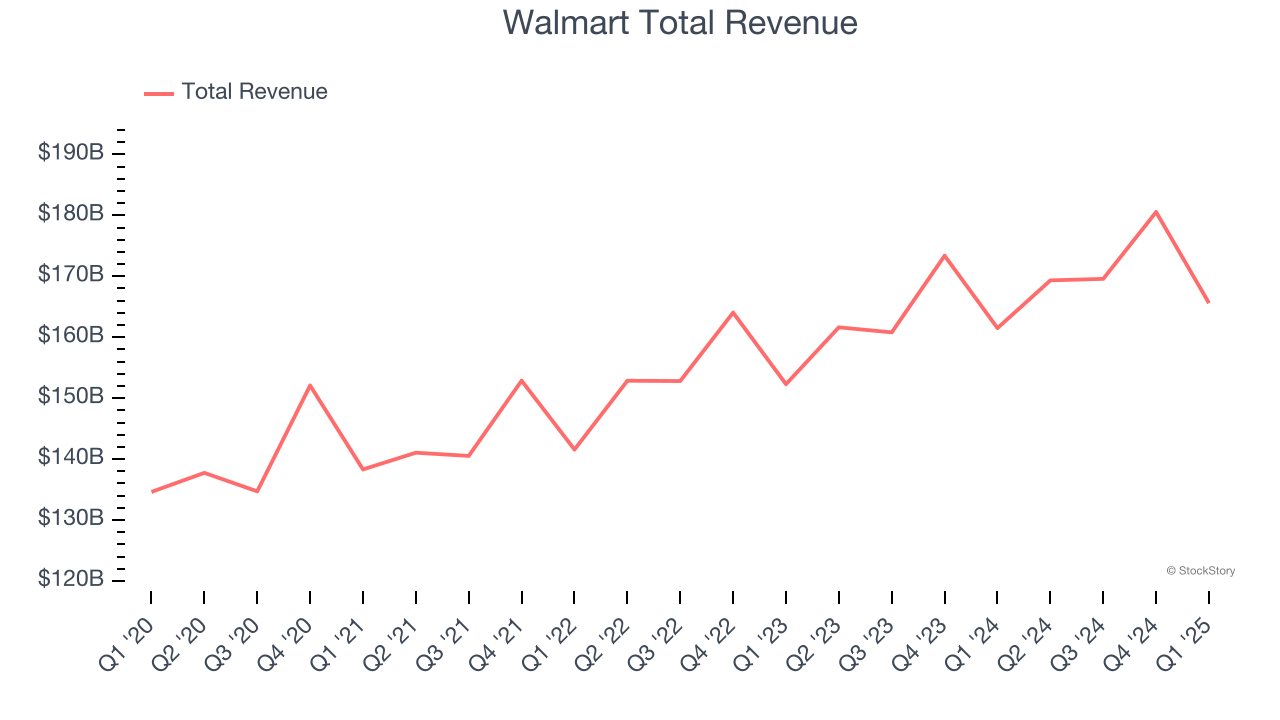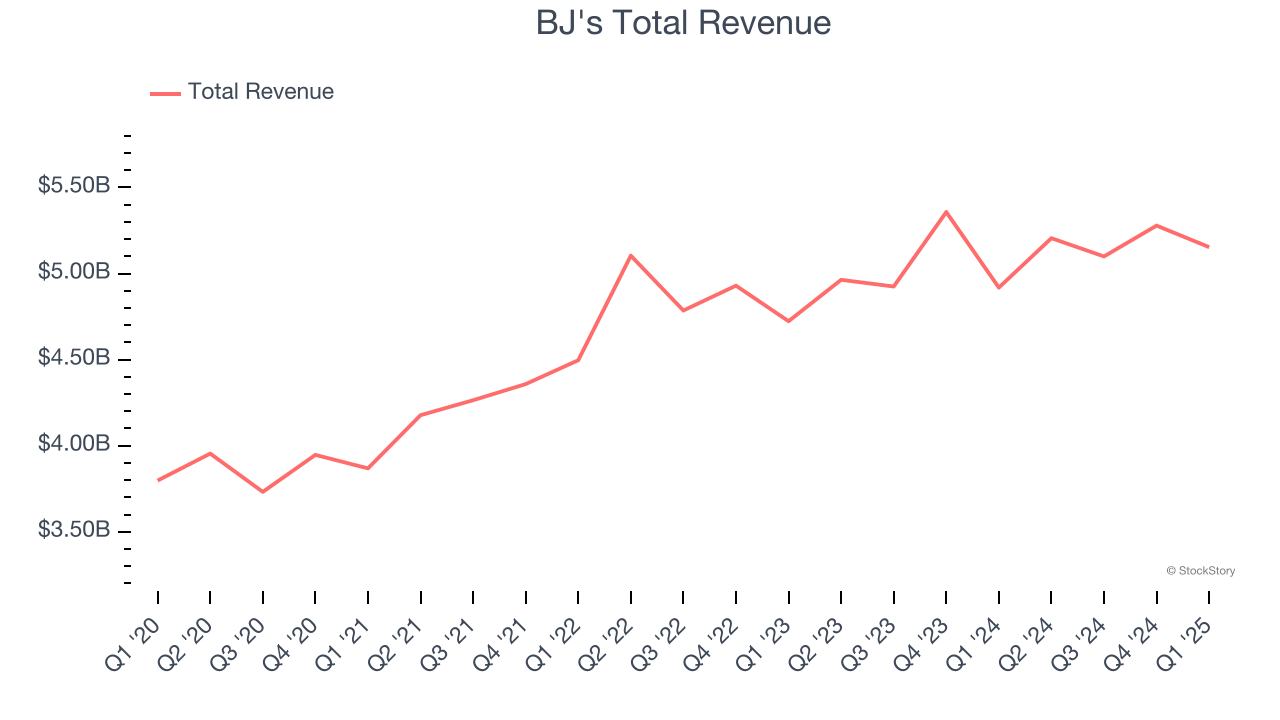
Looking back on large-format grocery & general merchandise retailer stocks’ Q1 earnings, we examine this quarter’s best and worst performers, including Walmart (NYSE: WMT) and its peers.
Big-box retailers operate large stores that sell groceries and general merchandise at highly competitive prices. Because of their scale and resulting purchasing power, these big-box retailers–with annual sales in the tens to hundreds of billions of dollars–are able to get attractive volume discounts and sell at often the lowest prices. While e-commerce is a threat, these retailers have been able to weather the storm by either providing a unique in-store shopping experience or by reinvesting their hefty profits into omnichannel investments.
The 4 large-format grocery & general merchandise retailer stocks we track reported a mixed Q1. As a group, revenues missed analysts’ consensus estimates by 0.7% while next quarter’s revenue guidance was in line.
While some large-format grocery & general merchandise retailer stocks have fared somewhat better than others, they have collectively declined. On average, share prices are down 1.3% since the latest earnings results.
Walmart (NYSE: WMT)
Known for its large-format Supercenters, Walmart (NYSE: WMT) is a retail pioneer that serves a budget-conscious consumer who is looking for a wide range of products under one roof.
Walmart reported revenues of $165.6 billion, up 2.5% year on year. This print was in line with analysts’ expectations, but overall, it was a mixed quarter for the company with an impressive beat of analysts’ gross margin estimates but full-year EPS guidance missing analysts’ expectations.

Unsurprisingly, the stock is down 1.1% since reporting and currently trades at $95.72.
Read our full report on Walmart here, it’s free.
Best Q1: BJ's (NYSE: BJ)
Appealing to the budget-conscious individual shopping for a household, BJ’s Wholesale Club (NYSE: BJ) is a membership-only retail chain that sells groceries, appliances, electronics, and household items, often in bulk quantities.
BJ's reported revenues of $5.15 billion, up 4.8% year on year, falling short of analysts’ expectations by 0.6%. However, the business still had a strong quarter with a solid beat of analysts’ EBITDA estimates and a solid beat of analysts’ EPS estimates.

Although it had a fine quarter compared its peers, the market seems unhappy with the results as the stock is down 8.3% since reporting. It currently trades at $107.74.
Is now the time to buy BJ's? Access our full analysis of the earnings results here, it’s free.
Weakest Q1: Target (NYSE: TGT)
With a higher focus on style and aesthetics compared to other large general merchandise retailers, Target (NYSE: TGT) serves the suburban consumer who is looking for a wide range of products under one roof.
Target reported revenues of $23.85 billion, down 2.8% year on year, falling short of analysts’ expectations by 2%. It was a disappointing quarter as it posted full-year EPS guidance missing analysts’ expectations.
Target delivered the weakest performance against analyst estimates and slowest revenue growth in the group. Interestingly, the stock is up 6.8% since the results and currently trades at $104.90.
Read our full analysis of Target’s results here.
Costco (NASDAQ: COST)
Designed to be a one-stop shop for the suburban consumer, Costco (NASDAQ: COST) is a membership-only retail chain that sells groceries, apparel, toys, and household items, often in bulk quantities.
Costco reported revenues of $63.21 billion, up 8% year on year. This result met analysts’ expectations. It was a satisfactory quarter as it also recorded a solid beat of analysts’ gross margin estimates.
Costco achieved the biggest analyst estimates beat and fastest revenue growth among its peers. The stock is down 2.8% since reporting and currently trades at $979.45.
Read our full, actionable report on Costco here, it’s free.
Market Update
The Fed’s interest rate hikes throughout 2022 and 2023 have successfully cooled post-pandemic inflation, bringing it closer to the 2% target. Inflationary pressures have eased without tipping the economy into a recession, suggesting a soft landing. This stability, paired with recent rate cuts (0.5% in September 2024 and 0.25% in November 2024), fueled a strong year for the stock market in 2024. The markets surged further after Donald Trump’s presidential victory in November, with major indices reaching record highs in the days following the election. Still, questions remain about the direction of economic policy, as potential tariffs and corporate tax changes add uncertainty for 2025.
Want to invest in winners with rock-solid fundamentals? Check out our Top 5 Quality Compounder Stocks and add them to your watchlist. These companies are poised for growth regardless of the political or macroeconomic climate.
StockStory is growing and hiring equity analyst and marketing roles. Are you a 0 to 1 builder passionate about the markets and AI? See the open roles here.





